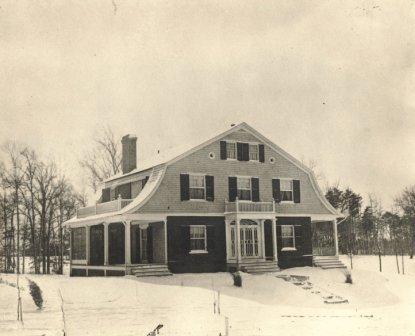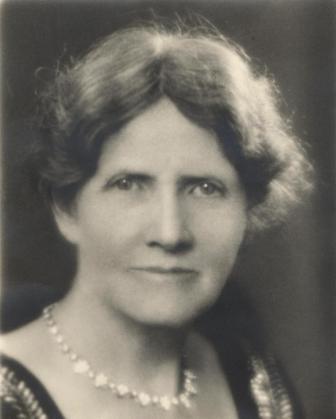Mary Brackett Robertson
One of the Four Founding Members of the Chevy Chase Reading Class
Mary Brackett Robertson, 1868-1962
Mary Brackett was born in Harpers Ferry, West Virginia in 1868. Her father Rev. Nathan Cook Brackett, a minister of the New England-based Free Will Baptist Church, served in the U.S. Christian Commission in the Shenandoah Valley during the Civil War. After the war, he continued his work to provide education for freed slaves, and, with the financial support of church leaders in Maine, he founded Storer College in Harpers Ferry. Rev. Brackett served as the first president of Storer, from 1867 to 1897. His wife, Mary Louise Wood Brackett, taught at the College, as did his twin sisters. Click Here to learn more about the Brackett family and Storer College at the West Virginia Encyclopedia website.
Mary attended the Nichols Latin School before entering Bates College, both located in Lewiston, Maine. After graduating in 1890, she taught Latin and Greek at Union Academy, in Illion, NY, for one year. In 1891, she returned to Harpers Ferry and began teaching at Storer College. She married Thomas E. Robertson (1871-1957), a patent attorney from Washington, DC, in 1897. They had three sons: Thomas (1898-1990), Nathan (1902-1950), and Louis (1905-2004). Their son Louis, in an interview for the CCHS Oral History Project, said they met when Thomas was bicycling in Harpers Ferry.
After their marriage, the Robertsons lived at 6 West Melrose Street in Section Two of Chevy Chase. Mr. Robertson bought the house in 1895, prior to their marriage. He was appointed Commissioner of Patents in 1921 and served until 1933.
Their grandson Donald Robertson, in an interview for the CCHS Oral History Project, remembers the Robertson house:
"The Melrose Street house was a magnificent house. It’s even more magnificent today. I have not been in it in more than fifty years, actually approaching sixty. … It’s a much more elaborate house now, but it was a very nice house, with two side porches, that in those days were open-air porches."
At different periods, other family members lived with Mary and Thomas at their house on Melrose Street, including Thomas’ parents, and for a period, his sister Grace Robertson Bowen and her husband Chester and their children, after they sold their house on Lenox Street. In the late 1930s, Thomas and Mary Robertson exchanged homes with their son Nathan (Donald Robertson’s father). They moved to Nathan’s smaller home on Shepherd Street in Section Three and the younger – still growing – family moved to the house on Melrose Street. This “switch” of family homes lasted until the elder Robertsons sold their Melrose Street home in 1947.

Louis Robertson remembered that the Robertsons had people who helped take care of the house and, most of the time, also lived at their household.
"Most of the time there was “live in” [help]. Before there was a “live in,” there was, as we called them very politely in those days, a "colored woman," whose name was Gracia. Later, if we were in formal conversation, we'd call them Negroes. I was not permitted to say "Nigger". And later, which will bring us to another subject, my mother hired an unwed mother named Dosia Simmons, who had a son named Richard, and they both lived on the upper floor attic of our house. The reason Mother hired her was because Mother was very active in the Florence Crittenton Home and was very sympathetic to the unwed mothers. Dosia was a very fine woman."
Donald Robertson also remembers his grandmother Mary:
"From the time of their marriage, I’m not aware that my grandmother worked for compensation. But she was very active in a variety of things, probably the most important of which was an organization known as the Florence Crittenton House…. My grandmother was very active in that. I don’t know that she was president of the whole operation, but she was president of the group that ran it."
The Florence Crittenton Home, located in Washington, DC, was a shelter for unwed mothers. Founded in New York City as a rescue mission in the 1880s, by 1933 this social service organization had grown to more than sixty homes across the nation. Mary Robertson was the President of the Lady Managers who ran the home in Washington, serving from 1916 to 1921, and again, from 1923 to at least 1933. She was also active in the National Crittenton Mission, and was vice-chairman of the Central Extension Committee. In a 1933 book published by the national organization, “Fifty Years’ Work with Girls, 1883-1933: A Story of the Florence Crittenton Homes,” by Otto Wilson, Mary Robertson’s work was described at the national level:
“Mrs. Robertson has been closely associated with the National almost from its beginning and although she has held no official position except that of vice-chairman of the Central Extension Committee, her advice has been of great value. At the various conferences she has always occupied an important place and her well prepared papers on various phases of Crittenton work have been bright features of the meetings. At the 1931 Conference, held in Wilmington, her paper on “Responsibility of Board Members” was particularly fine and has been reprinted at the request of many of the Homes.” (Page 87)
Her position as President of the Lady Managers of the Florence Crittenton Home in Washington is described in the same book:
“…for the past ten years [she] has been a major factor in developing the Washington Crittenton Home into a model institution. During her presidency the new home was secured and completely paid for, the hospital built and fully equipped, and under her supervision the Home has taken advantage of every opportunity for service to lives entrusted to its care.” (Page 481)
Both her son Louis and grandson Donald remember her participation in the Reading Class for more than sixty years. Donald recalled in his oral history interview:
"On a wholly different level she was one of the organizers of something called the Chevy Chase Reading Class…. My grandmother and my aunt, Grace Robertson Bowen, who also lived in the neighborhood, were very active in this."
In 1897, Mary Robertson and her husband were among the founding members of All Saints’ Episcopal Church, on Chevy Chase Circle. Thomas was among the first group of vestrymen, and Mary was a charter member of the St. Agnes Guild which began in 1899. Both Mr. and Mrs. Robertson remained active in their church, even after they sold their home on Melrose Street and moved to Piney Branch Road in Takoma Park in 1947.

Mary and Thomas were also members of the Literary Club of the Chevy Chase Association, hosting monthly meetings from time to time, as well as presenting papers on a variety of topics. Both held leadership positions in this group: in 1910, Mary was elected the Secretary of the Literary Club and Thomas was elected the Chair of the Program Committee. In addition, the Robertsons participated in the fund raising activities of the Chevy Free Library Association.

Many of Mary’s friends and colleagues in the Chevy Chase Reading Class were members of these same organizations, especially the Free Library Association and the Literary Club. For example, a number of the women in the St. Agnes Guild at All Saints’ Church were also members of the Reading Class. In 1903, those women included Minnie N. Swartzell, Katherine Jones Dawson, Mary and Helen Childs, Helen Zimmerman Tucker, and Mary’s sister-in-law Grace Robertson Bowen. Another member of the St. Agnes Guild, Miss Lucy Mackrille, was a stalwart member of the Literary Club, and joined the Reading Class in 1921. And a member of the reading class in 1912-1914, Mary Bradford Stone, was also involved with the Florence Crittenton Circle, a local group which raised funds for the organization.
We can only sketch the outlines of Mary Robertson’s friendship ties made through these various organizations -- the literary groups, All Saints’ Church, and the Florence Crittenton Home. They suggest a well-educated woman with a strong ethic for social service. She was an active participant in her community – in Chevy Chase, and Washington, DC. Like many other educated upper and middle-class women in the Progressive Era in cities and new suburbs like Chevy Chase, she was a “community builder,” using her knowledge and skills to help build important community institutions.
In his oral history interview, her son Louis remembers his parents, and especially his mother Mary:
"Actually, I not only loved them both but held them in extremely high esteem. They were both not just “good people,” but unusually so. They were both very public-spirited, and inclined to take action when they saw a chance to benefit their community or beyond. I believe that they were both highly regarded in the community and by associates in their respective wide-ranged activities. I doubt that I ever heard my mother speak ill of anyone -- though this does not mean that she would not show disapproval of words or actions when this was necessary."
Mary Robertson was still attending the meetings of the Chevy Chase Reading Class in 1962, the year she died.



